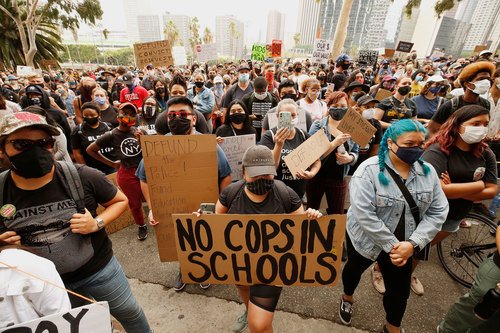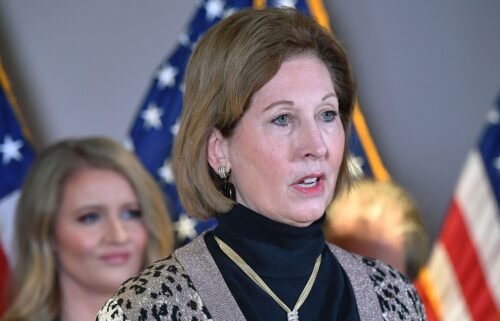A movement to push police out of schools is growing nationwide – Here is why

Soon after George Floyd died at the hands of police in Minneapolis, the city’s public school district voted to push police out of its schools.
The move has inspired many other districts across the US to make a similar decision — or at least consider it.
School officials in Denver, Milwaukee and Portland, Oregon, have all announced they are severing ties with police.
And in California, the state’s Department of Education is pushing for a reevaluation of police on school campuses, specifically as it relates to racial justice, Superintendent Tony Thurmond said last week. Hours later, the school board in Oakland, California, unanimously voted to disband the school district’s police department as part of what they called the George Floyd Resolution.
School resource officers have been a common fixture in American public schools for decades. They are meant to keep campuses safe, and even mentor students. But activists say these officers have been criminalizing Black and Latino students.
Floyd’s death ignited calls to defund and abolish police departments and is revitalizing the movement against school policing. Here’s why many advocates say police brutality doesn’t just happen in the streets — and why they believe removing officers from schools is critical to racial equality.
Why are cops in schools?
School resource officers, or SROs, have been part of K-12 public schools in America since the 1950s, according to the US Department of Justice.
SRO programs were initially a way to build relationships between police and young people in some cities, but the practice spread widely and with a greater emphasis in security following the 1999 Columbine shooting.
These officers have the same training, the same capabilities and the same resources as other members of the police or sheriff’s department — but their roles are more multifaceted. They settle disputes, monitor bus traffic and simply provide security, all while serving as counselors, mentors and sometimes teachers.
But some SROs have been accused of using excessive force toward students and contributing to the school-to-prison pipeline, according to an ACLU report published in 2017.
While there’s not an official nationwide database of SROs, the National Center for Education Statistics estimates there were at least 52,100 officers working in US public schools in 2016. That includes full-time and part-time officers.
The Department of Justice has granted millions of dollars to fund SROs for decades through different initiatives, but there’s no national standard training requirements for officers deployed in schools.
Only 24 states and the District of Columbia have passed laws addressing SRO training and those statues are not uniform, according to a report by Strategies for Youth, a non-profit aiming to improve interactions between police and young people.
Violent confrontations can scar students
Many confrontations between police officers and students in schools have become violent, mirroring some interactions between law enforcement and people on city streets.
Last year, officers in North Carolina were accused of body slamming boys and girls, holding them in a chokehold, and officers in Orlando, Florida, arrested 6-year-old girls for reportedly having a tantrum.
Those interactions have scarred students like Amir Lumumba, 12, who watched a SRO at his elementary school in Dayton, Ohio, place one of his classmates in handcuffs after a fight broke out.
“I was in disbelief,” Amir told CNN. “There’s more than one way to get a kid out of a classroom. You don’t have to put them on the ground, handcuff them to get them to go to the office.”
Amir, who is now an 8th grader in Montgomery County, Maryland, has been advocating for months against expanding the Montgomery Public Schools’ SRO program to middle schools.
Students of color and those with disabilities are often disproportionately punished, advocates and students say.
During the 2015-2016 school year, over 290,600 students were referred to law enforcement agencies or arrested, according to the US Department of Education Office for Civil Rights.
Black students represented 15% of the student body, and 31% of the referral or arrests. Sixty-five percent of the arrests were students of color or mixed races.
“I don’t think SROs should be in school because I feel like young black boys, like myself, we are more often targeted than other people,” Amir said.
What would police-free schools look like?
It’s unclear how schools districts would redirect the funding previously allocated for on-campus sworn officers.
Some advocates, like Keri Smith, deputy director for Padres & Jóvenes Unidos in Denver, are concerned those funds will be used to reinforce other infrastructures or systems that still criminalize the youth.
“We want police out of schools and not just bodies,” Smith said. “We don’t want to take police out and add more cameras and more metal detectors.”
Instead, school officials should look into funding art and music programs and increasing the number of counselors, Smith said.
In American public schools, the average ratio is 430 students per counselor, according to the American School Counselor Association. The ASCA recommends an average ratio of 250 students.
Jasmin Benas, 18, started a petition calling for the removal of SROs from Wake County Public Schools, the largest school district in North Carolina. She believes the money can and should be allocated elsewhere.
“It’s extremely unnecessary and a bad allocation of money (SRO program) considering the fact that we only have one social workers in a school with 2,000 students or we have one nurse, one day a week for 2,000 students,” Benas told CNN.
Benas said after Floyd’s death and clashes between police and protesters in Raleigh, she and her classmates began questioning the ways they have been traditionally disciplined and how school resources are being distributed.
The petition has now amassed more than 4,000 signatures.
Some say SROs are still the best community-based policing
For Mo Canady, the executive director of the National Association School Resource Officers, it’s disappointing to see communities moving to remove SROs from schools without first considering more additional training or other changes to the way the officers operate.
“If school districts have good, sound SRO programs, then they are eliminating what could be the best community based policing program any community could have,” Canady told CNN.
SROs play a role in preventing school shootings, and have stopped them in the past. But they also serve as a deterrent to other types of crime, he said.
“There are going to be assaults, there are going to be drug issues on campus, there are going to be trespassers,” Canady said. “There are are going to be dangers that come from the outside in that are not just in the active shooter category.”
Some school officials agree that SROs can have a positive impact on campuses.
“We’ve seen less violence, less suspensions. We’ve seen more academics and more kids wanting to be law enforcement officers,” Art McCoy, superintendent of the Jennings School District in St. Louis County, Missouri, told CNN.
Students in the Missouri school district will continue seeing and interacting with sworn officers when they return to campus, he said.
The school district has made some adjustments in recent years, following the 2014 killing of Michael Brown, McCoy said.
The district made an agreement with St. Louis County police that officers must represent at least 75% of the student demographic, which is predominantly Black, or at least come from the neighborhoods served by the district.
“That’s the level of respect and redistribution of power,” McCoy said. “It’s about making it a community that loves one another.”
“It’s not them against us, it’s just all us,” the superintendent added.
Canady — along with some school leaders — believe the clashes between SROs and students, including violent incidents, can be prevented if officers have the right training.
Most law enforcement officers have some training on juvenile issues, but SROs should undergo additional training on implicit bias and adolescent mental health issues, Canady said.
“If we don’t figure out a way to repair this relationship, starting with youth,” Canady said, “then we’re going to have one more generation of adults eventually where there is that disconnect.”


